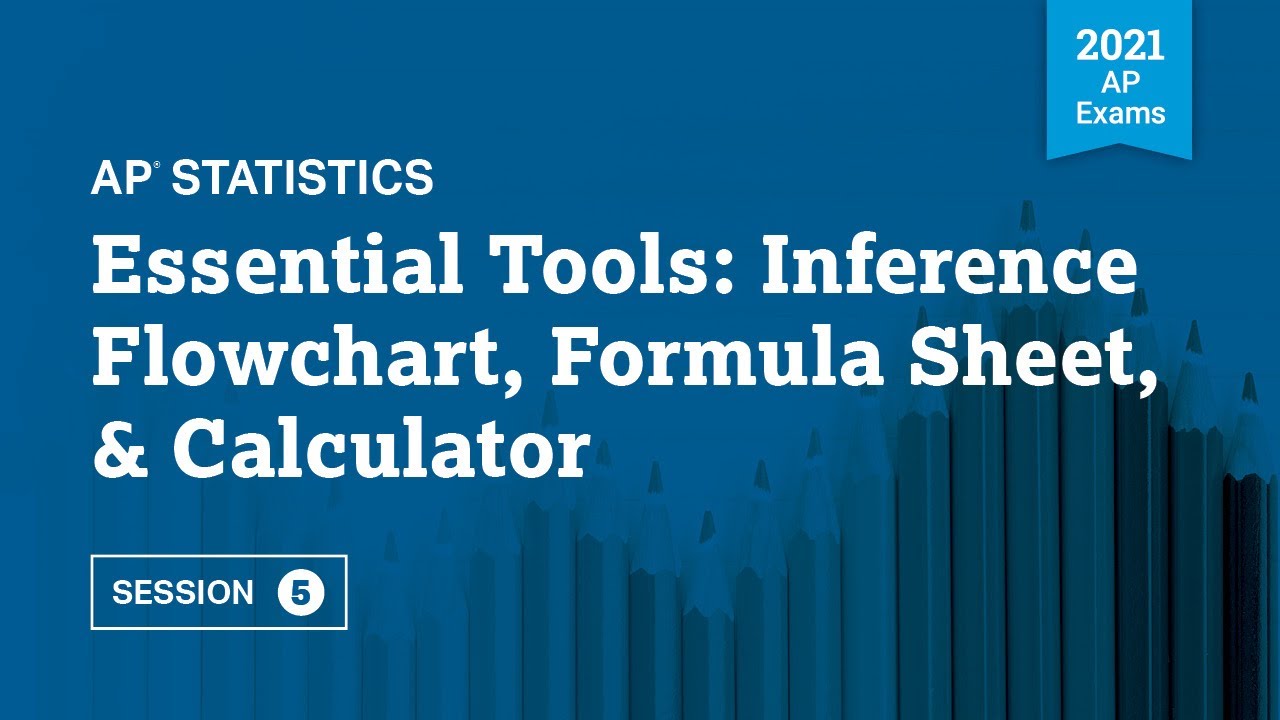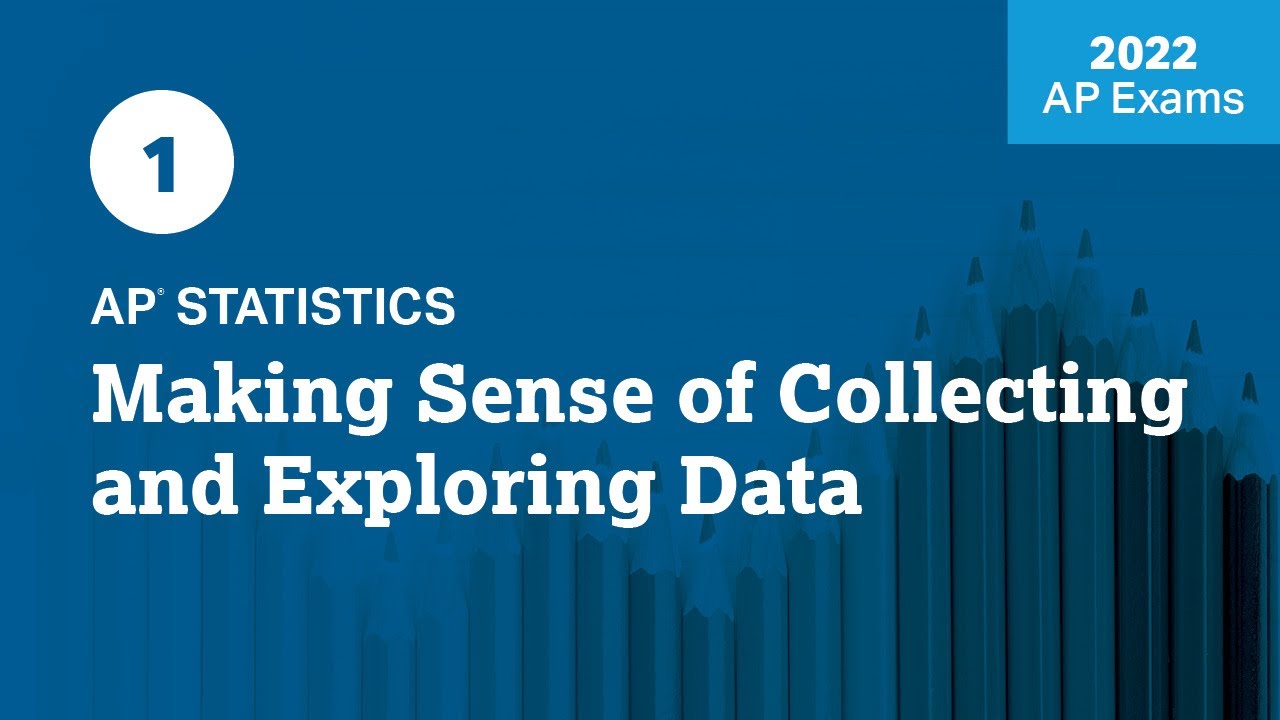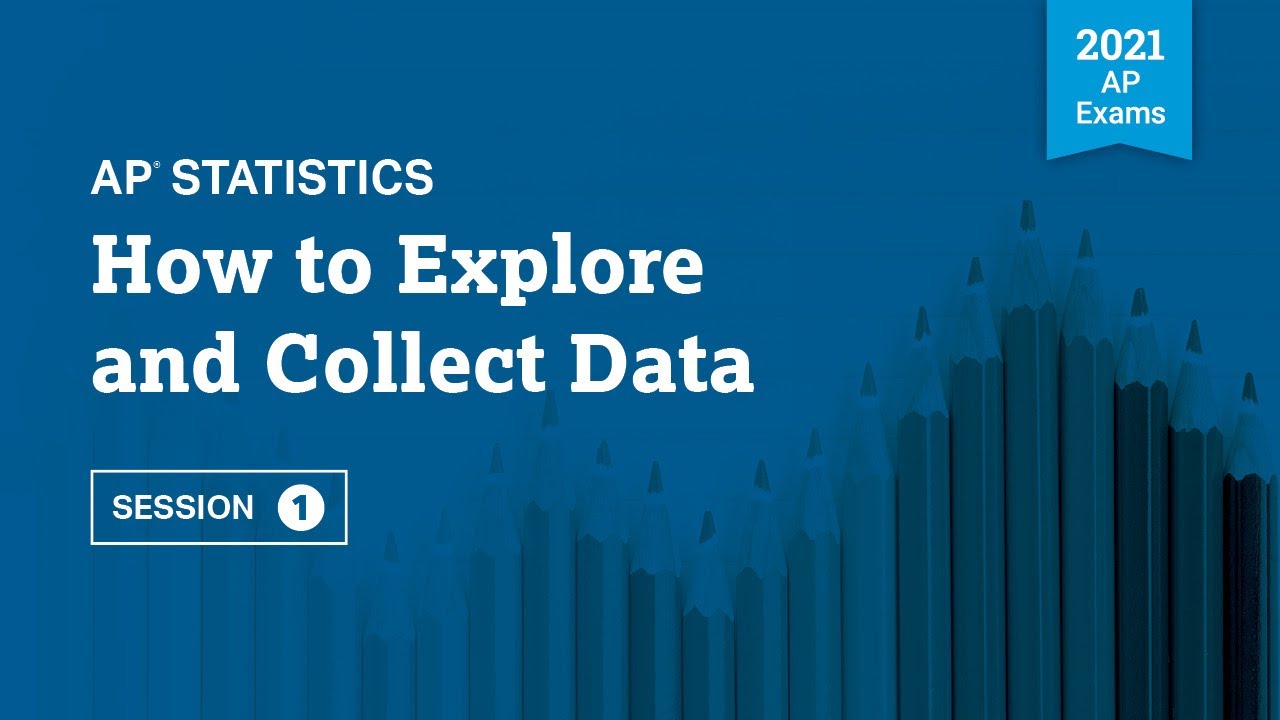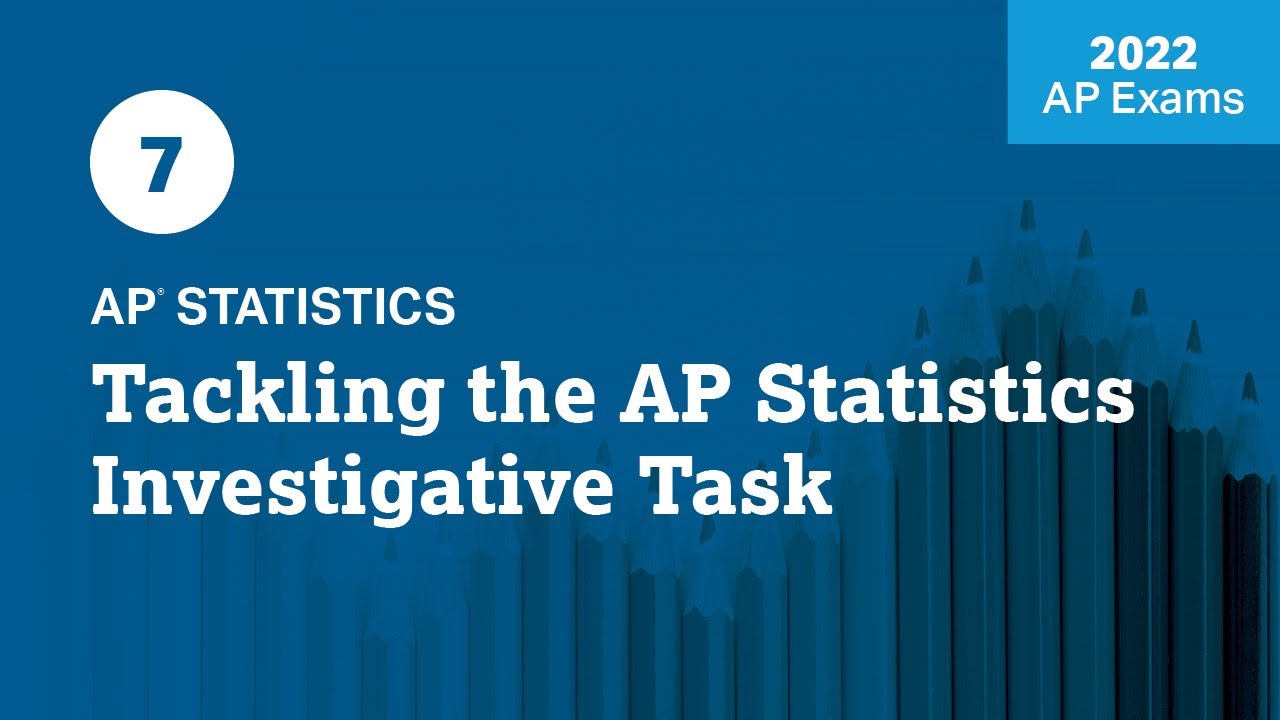2021 Live Review 7 | AP Statistics | Taming the Investigative Task on the AP Statistics Exam
TLDRIn this AP Statistics review session, teacher Luke Wilcox focuses on the Investigative Task, a crucial free-response question that can significantly impact students' AP scores. He outlines five strategies to tackle this question, emphasizing the importance of staying calm and tackling the task step by step. Wilcox provides clarity on statistical concepts, such as the difference between binomial and geometric random variables, and conditions for inference. The session includes practical examples from past AP exams to demonstrate these strategies in action, aiming to simplify challenging content and build students' confidence for the exam.
Takeaways
- 📚 The session focuses on the AP Statistics exam's Free Response Question 6, known as the Investigative Task, which can significantly impact students' AP scores.
- 🔍 The Investigative Task is designed to assess multiple skill categories and content areas, requiring students to apply their skills in new and non-routine ways.
- 👨🏫 Luke Wilcox, an AP Statistics teacher, shares five specific strategies to tackle the Investigative Task effectively.
- 📈 Understanding the difference between Binomial and Geometric random variables is crucial, with Binomial focusing on a fixed number of trials and Geometric on the number of trials until the first success.
- 📝 When conducting inference, three key conditions must be considered: randomness in sampling or assignment, the 10% condition for sampling without replacement, and the shape of the sampling distribution.
- 🧐 The Investigative Task often involves creating or interpreting new statistics, such as using the ratio of the sample mean to the median to detect skewness in a distribution.
- 📉 The task may require analyzing box plots and histograms to determine the shape of the data distribution and make inferences about the population.
- 🤔 Students are encouraged to remain calm and not to give up when faced with unfamiliar aspects of the Investigative Task, using their statistical reasoning skills to navigate through.
- ⏱️ Time management is key during the exam, with an advised 25 minutes dedicated to the Investigative Task out of the 90 minutes allocated for the free response section.
- 📊 The use of flowcharts and alignment guides provided in the session materials can aid students in systematically approaching statistical problems.
- 🔑 The Investigative Task is the last question in the free response section and is worth 25 points, emphasizing its importance in the overall AP exam score.
Q & A
What is the main focus of the session seven of AP Daily Live Review for AP Statistics?
-The main focus of session seven is on the investigative task, which is the free response question number six on the AP exam, aimed at increasing students' AP scores by one full point.
Who is the presenter of the session and where is he from?
-The presenter of the session is Luke Wilcox, an AP Statistics teacher from East Kentwood High School in Kentwood, Michigan.
What is the significance of the investigative task in the AP Statistics exam?
-The investigative task is significant because it is a question that the students are guaranteed to see on the AP exam and it has the potential to increase their AP score by one full point.
What are the three conditions that need to be considered when performing inference in statistics?
-The three conditions are the random condition (either a random sample or random assignment in an experiment), the 10 condition (sample size less than 10% of the population when sampling without replacement), and the condition about the shape of the sampling distribution (approximately normal or chi-square for different tests).
What is the difference between a binomial random variable and a geometric random variable?
-A binomial random variable counts the number of successes in a fixed number of trials, while a geometric random variable counts the number of trials until the first success.
What is the recommended time to spend on the investigative task during the AP exam?
-It is recommended that students spend about 25 minutes on the investigative task during the AP exam.
What is the importance of staying calm during the investigative task in the AP exam?
-Staying calm is important because the investigative task is designed to present students with new and unfamiliar problems. Remaining calm allows students to apply their statistical thinking and reasoning skills effectively.
What is the purpose of the flowchart presented in the session?
-The flowchart is used to guide students through the process of determining the appropriate statistical inference procedure based on the characteristics of the data and the type of question being asked.
How does the session help students with the investigative task from previous AP exams?
-The session helps by providing specific strategies, analyzing past investigative tasks from previous AP exams, and demonstrating how to apply the strategies to solve these tasks.
What is the investigative task's position and worth in the AP Statistics exam?
-The investigative task is the sixth and final free response question in the AP Statistics exam, and it is worth 25 points of the free response score, which is approximately 12.5% of the total AP exam score.
What is the advice given for students who get stuck on a part of the investigative task?
-If students get stuck on a part of the investigative task and need the answer for a later part, they should make up a reasonable answer to use in the later part to ensure they can still get credit even if their previous answers were incorrect.
What is the concept of bootstrapping as mentioned in the script?
-Bootstrapping is a resampling technique used to estimate the sampling distribution of a statistic by taking many random samples with replacement from the original sample and calculating the statistic of interest for each resampled dataset.
How can a student develop a theoretical sampling distribution of the sample median for samples of size 50?
-A student can develop a theoretical sampling distribution of the sample median by obtaining every possible sample of size 50 from the population, computing the median of each sample, and then collecting all possible sample medians.
What is the purpose of the confidence interval constructed using the bootstrap distribution?
-The purpose of the confidence interval is to provide an estimate range for the population median, indicating that we are a certain percentage confident that the true median falls within this interval.
How is the session structured to help students prepare for the AP exam?
-The session is structured by first presenting quick facts about the investigative task, discussing suggested strategies, showing these strategies in action with examples from previous AP exams, and maintaining goals to simplify content, share specific strategies for AP exam success, and build confidence.
Outlines
📚 Introduction to AP Statistics Review Session 7
In this session, Luke Wilcox, an AP Statistics teacher, welcomes students to the seventh live review of AP Statistics, focusing on the Investigative Task, a critical free-response question on the AP exam. He emphasizes the potential of this question to significantly boost students' AP scores and outlines five strategies to tackle it effectively. The session includes logistical information about accessing materials and gathering feedback, as well as addressing common questions from previous sessions, such as the difference between binomial and geometric random variables and conditions for statistical inference.
🔍 Dissecting the Investigative Task and Inference Conditions
The paragraph delves into the specifics of the Investigative Task, its significance in the AP exam, and the general approach to tackle it. It discusses the importance of understanding the random condition in sampling and experiments, the 10% condition for sampling without replacement, and conditions for a normal sampling distribution. The summary also touches on the importance of checking these conditions in inference procedures like confidence intervals and significance tests, and it highlights the need for students to be familiar with these concepts to successfully complete the Investigative Task.
📝 Strategies for Mastering the Investigative Task
This section provides a detailed overview of the strategies to excel in the Investigative Task. It starts with a reminder to stay calm when encountering unfamiliar questions, as the task is designed to present new scenarios. The summary explains the importance of recognizing that the task will cover various units from the course and the necessity of securing points on the easier parts before tackling more complex sections. It also advises making educated guesses if stuck and the value of referencing previous answers in the final summary part of the task.
🚀 Applying Strategies to Past Investigative Tasks
The speaker illustrates the application of the discussed strategies by analyzing an Investigative Task from the 2009 AP exam. The task involves assessing the average fuel efficiency of a car model, and the summary walks through defining the parameter of interest, stating null and alternative hypotheses, and identifying the type of inference procedure required. It also addresses common student errors in hypothesis formulation and emphasizes using the correct terminology when referring to population parameters.
📉 Analyzing Distributions and Hypothesis Testing
This paragraph examines the process of hypothesis testing when faced with skewed distributions, using a scenario where the mean may be affected by outliers. It discusses the use of the sample mean to median ratio as an indicator of skewness and explains how a ratio greater than one suggests a right-skewed distribution. The summary also covers the concept of simulated sampling distributions to assess the plausibility of a normal population distribution, introducing the idea of estimating p-values from simulated data.
📊 Crafting a Statistic for Skewness and Interpreting Results
The speaker introduces a method to define a statistic for measuring skewness using the five-number summary from a data set. The summary explains how to create a box plot to visualize the distribution and suggests a statistic based on the ratio of the distances from the median to the maximum and minimum values. It emphasizes that a ratio greater than one indicates a right-skewed distribution and acknowledges that there are multiple correct ways to define such a statistic.
🏘️ Estimating Rental Prices and Understanding Populations
This section discusses Emma's investigation into the rental prices of one-bedroom apartments, focusing on the appropriate population for generalizing her sample results. The summary explains the concept of random sampling and its representativeness of the population, and it identifies the specific population that Emma's sample can be generalized to, which is one-bedroom apartments listed on a particular website by voluntary posters.
📊 Disadvantages of Using the Mean in Skewed Distributions
The speaker highlights the disadvantages of using the mean as an estimate of typical rental prices when the distribution is skewed to the right. The summary explains that the mean can be significantly larger than the median due to the influence of outliers, making the median a more accurate representation of typical prices. It emphasizes the importance of using the median to avoid overestimating typical rental prices.
🔧 Developing a Theoretical Sampling Distribution for the Median
This paragraph explores the process of developing a theoretical sampling distribution for the sample median, even without prior knowledge of bootstrapping. The summary explains the concept of obtaining every possible sample and calculating the median to build the sampling distribution. It also addresses the practical approach of using bootstrapping to approximate this distribution by taking random samples with replacement and calculating the median of each.
🔢 Calculating Percentiles and Constructing Confidence Intervals
The speaker demonstrates how to calculate percentiles from a bootstrap distribution and use them to construct a confidence interval for the median rental price. The summary details the steps to find the fifth and ninety-fifth percentiles and the percentage of bootstrap medians between these values. It concludes with the interpretation of a 96% confidence interval for the median rental price, emphasizing the importance of context in the interpretation.
🗣️ Reflecting on Investigative Task Strategies and Confidence Building
In the final paragraph, the speaker reflects on the session's objectives and the strategies discussed for tackling the Investigative Task. The summary reviews the importance of perseverance, understanding sampling distributions, and the significance of statistical inference in these tasks. It also highlights the value of the session in reducing anxiety around the Investigative Task and building confidence for the AP exam, inviting feedback for further improvement.
Mindmap
Keywords
💡AP Statistics
💡Investigative Task
💡Free Response Question
💡Inference Procedure Flow Chart
💡Random Sample
💡Binomial Random Variable
💡Geometric Random Variable
💡Conditions for Inference
💡Normal Large Sample Condition
💡Bootstrapping
💡Confidence Interval
Highlights
Introduction to AP Statistics session 7 focusing on the Investigative Task.
Potential of the Investigative Task to increase AP scores by one full point.
Strategies to tackle the Investigative Task effectively.
Availability of materials for the session at a specified URL.
Feedback summary from previous sessions to address common questions.
Explanation of the difference between binomial and geometric random variables.
Conditions for inference in statistical analysis.
Random condition and its importance in generalization and causation.
10% condition for sampling without replacement.
Normality condition for sampling distribution in inference.
Overview of the AP exam structure and the significance of the Investigative Task.
Description of the Investigative Task's role in assessing multiple skill categories.
Calm approach to the Investigative Task despite its novelty.
Expectation of questions spanning multiple units of the course.
Emphasis on securing points on the easier parts of the Investigative Task.
Use of made-up answers for later parts if stuck on previous sections.
Importance of referencing previous parts in the final question of the task.
Practical demonstration of strategies on Investigative Tasks from past AP exams.
Analysis of a 2009 AP exam Investigative Task regarding car fuel efficiency.
Application of the mean vs. median concept in skewed distributions.
Introduction and explanation of bootstrapping as an estimation method.
Construction of a confidence interval using bootstrapping results.
Interpretation of confidence intervals in the context of the Investigative Task.
Final review of strategies and key takeaways from the session.
Transcripts
Browse More Related Video

2022 Live Review 2 | AP Statistics | Making Sense of Probability & Random Variables

2021 Live Review 5 | AP Statistics | Essential Tools Inference Flowchart, Formula Sheet & Calculator

2022 Live Review 1 | AP Statistics | Making Sense of Collecting and Exploring Data

2021 Live Review 1 | AP Statistics | How to Explore and Collect Data

2022 Live Review 7 | AP Statistics | Tackling the AP Statistics Investigative Task

1 | MCQ | Practice Sessions | AP Statistics
5.0 / 5 (0 votes)
Thanks for rating: